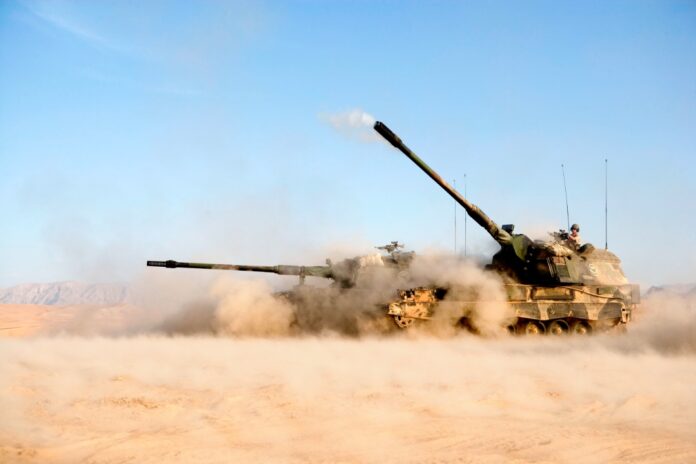
Developments in artillery ammunition are seeing greater ranges with better accuracy for tube artillery.
Traditionally, the main role of conventional tube artillery, be it self-propelled (SP) or towed, is not only to provide suppressive fire against threat forces using high explosive (HE) projectiles, but also to fire more specialised ammunition such as illuminating, smoke, top attack of various types, and more recently precision guided munitions (PGM).
Today the field artillery arm is demanding not only higher rates of fire but increased range and more accuracy. Higher rates of fire can be achieved by automating the ammunition handing system (AHS) on SP artillery platforms. Such is the case in the German Krauss-Maffei Wegmann 155mm/52 calibre PzH 2000 SP artillery system which has a semi-automated AHS in which the fuzed 155mm projectile is loaded automatically and the modular charge system (MCS) then loaded manually.
In the longer term, a fully automated AMS could be installed in the PzH 2000 in which the fuzed projectile and the MCS would both be loaded automatically. This would have the added advantage of reducing the crew members by two as well as increasing the rate of fire.
For many years the 155mm/39 calibre ordnance installed in SP artillery systems such as the US M109A3 tracked SP artillery system was the most widely deployed in NATO and many other countries. It could fire a standard 155mm M107 HE projectile a maximum range of just over 18 kilometres (11 miles) which is very short by today’s standards. An increase in range can be achieved by the installation of a Rheinmetall 155mm/52 calibre ordnance with a 23 litre chamber that meets the NATO Joint Ballistic Memorandum of Understanding (JBMoU).
The maximum range of a conventional tube artillery system depends on a number of factors including where the weapon is positioned (eg. altitude) and the type of projectile/charge combination being used to engage the target. A good example again is the PzH 2000 which can achieve a maximum range of 30km (18.6 miles) using the 155mm DM111/DM121 HE projectile, 40km (24.8 miles) for a 155mm HE Base-Bleed (BB) projectile and 54km (33.5 miles) using the South African Rheinmetall Denel Munitions Velocity Enhanced Artillery – Projectile (V-LAP).
The previously mentioned 155mm M107 HE round is an old design but is still used, especially for training, as it is cheaper and its shorter range enables it to be used on more artillery firing ranges.
Range can be increased in a number of ways including a redesigned 155mm artillery projectile with tighter manufacturing standards such as being machined inside and outside as well as having a more streamlined design with the option of a hollow base (HB) to reduce drag.
BB and rocket assist (RA) can increase range but with all artillery systems as the range increases so the circular area of probability (CEP) increases and adjustment of fire is required to bracket the target. A new family of 155mm ammunition is that recently developed by NAMMO with the HE-Extended Range (HE-ER) having a maximum range of 41km (25.4 miles) when fitted with a BB unit and fired from 155mm/52 calibre ordnance. This is reduced to a maximum range of 30km (18.6 miles) when fired from a 155mm/39 calibre ordnance.
It is available with an insensitive munition (IM) filling with more specialised rounds of the family including Illuminating ER/Infra-red Illuminating ER, Smoke ER and Target Practice ER. In addition the company is marketing a 155mm HE projectile with a HB which has a maximum range of up to 24km (nearly 15 miles).
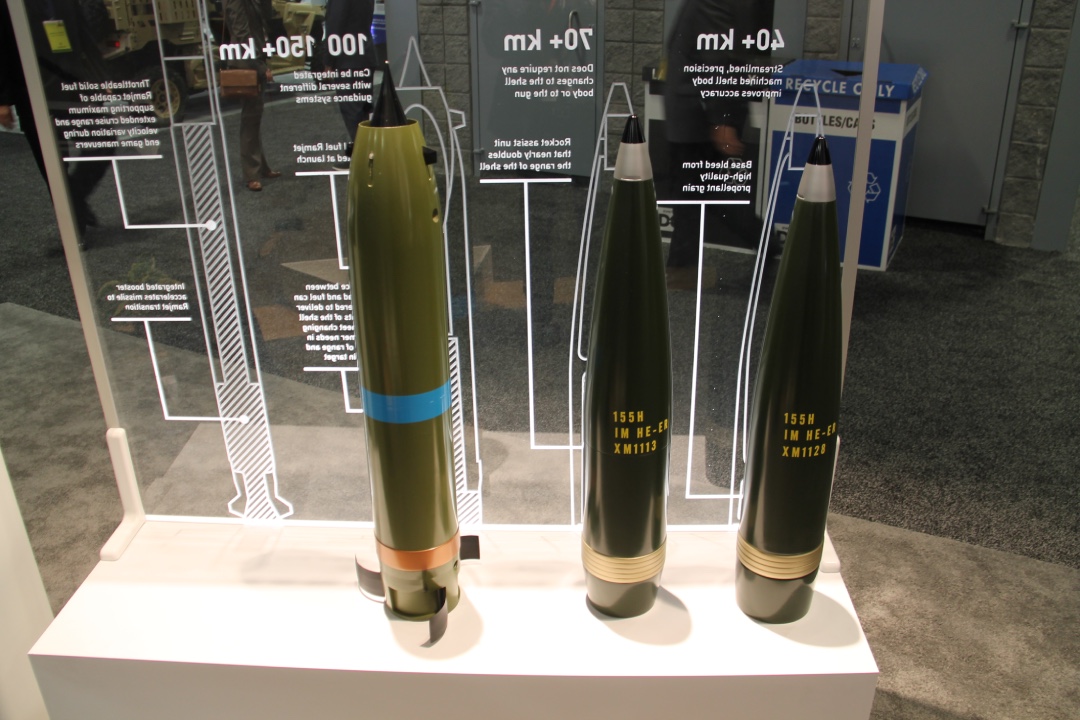
Currently under development are ramjet powered 155mm artillery projectiles, but these will have a smaller payload and their control attachments make them easier to detect with artillery locating radars (ALR). In October 2021 NAMMO announced that it had completed more than 300 rocket motor tests that had yielded important feedback in the development process.
The company added that current designed ramjet motors could be fired from 155mm 39/52 or 58 calibre artillery and that they had already demonstrated reliable ignition and in-house flight. For the US market, NAMMO is teamed with Boeing.
Greater accuracy can be obtained but fitting a precision guidance kit (PGK) with the most widely used one being the now Northrop Grumman M1156 PGK which has been produced in large numbers for the US Army and Marine Corps and an increasing number of export customers. According to Northrop Grumman, use of the M1156 PGK gives an 75 percent reduction in HE rounds for the same effect.

Other developments include Nexter’s Spacido while the Israel Defense Force (IDF) has adopted the Israel Aircraft Industries Top Gun for its 155mm artillery projectiles.
US seeks more range
It was expected that the US Army would have fielded the advanced Crusader 155mm SP artillery system and its associated ammunition resupply vehicle. This was cancelled following the end of the cold war as was the Non-Line-Of-Sight Cannon (NLOS-C) which was part of the ambitious Future Combat System (FCS).
The US Army continues to upgrade its M109 series of SP howitzer to the latest M109A7 Paladin Integrated Management (PIM) but these currently still retain their 155mm/39 cal ordnance. In the not-to-distant future ordnance will be replaced by the 155mm/58 calibre Extended Range Artillery Cannon (ERAC) which is a key part of the US Army’s Long Range Precision Fires (LRPF) project.
This 155mm/58 calibre ordnance will be back-fitted to the latest M109 which will also feature an automated AHS to enable a higher rate of fire to be achieved as well as firing a new family of 155mm ammunition.
Rheinmetall provides the 155mm/52 calibre ordnance for the PzH 2000 SP artillery systems but is now working on a 155mm/60 calibre ordnance with the first application being for their 10×10 SP artillery system revealed in late 2021.
Engaging armoured targets
For many western armies 155mm artillery projectiles containing bomblets were the standard means to try and neutralise massed attacks by armoured fighting vehicles (AFV) and other platforms. The most widely used were the US 155mm M483A1 which carried 64 M42 and 24 M46 dual purpose top attack grenades and when fired from a 155mm/39 calibre system had a maximum range of 17.5km (10.8 miles).
The main drawback of these sub-munitions was the high dud rate when fired over some types of terrain such as sand or soft soil which were hazardous to follow up forces as well as civilians and for these reason these are now banned by an increasing number of countries.
There are two top attack 155mm artillery projectiles deployed in the West; the German SMArt 155 and the French/Swedish Bonus and both of these have top attack sub-munitions which will penetrate vulnerable upper surfaces of an AFV.
Precision artillery projectiles
The United States deployed the 155mm M712 Copperhead Cannon Launched Guided Projectile (CLGP) in Gulf War One but have now run out of shelf life. Russia is currently marketing 155mm, 152mm and 122mm Laser Guided Projectiles (LGP) as is China.
The main disadvantage of these LGP is that the designator has to have line-of-sight to the target which in some terrain and weather conditions can be difficult. Airborne assets can also be used to designate targets and some ground based assets can designate the target with the actual LGP being launched by another platform.
The Raytheon Excalibur 155mm M982 is the most widely used 155mm PGM in the West, was used extensively use in Afghanistan and Iraq and has been continuously developed with a recent model being laser guided. These PGM are not cheap and would only be used to engage high value targets.
In November 2021 the US Army activated its 56th Artillery Command in Germany which in the longer term will be equipped with the Dark Eagle hypersonic missile which will provide a step change in the US Army artillery capability.
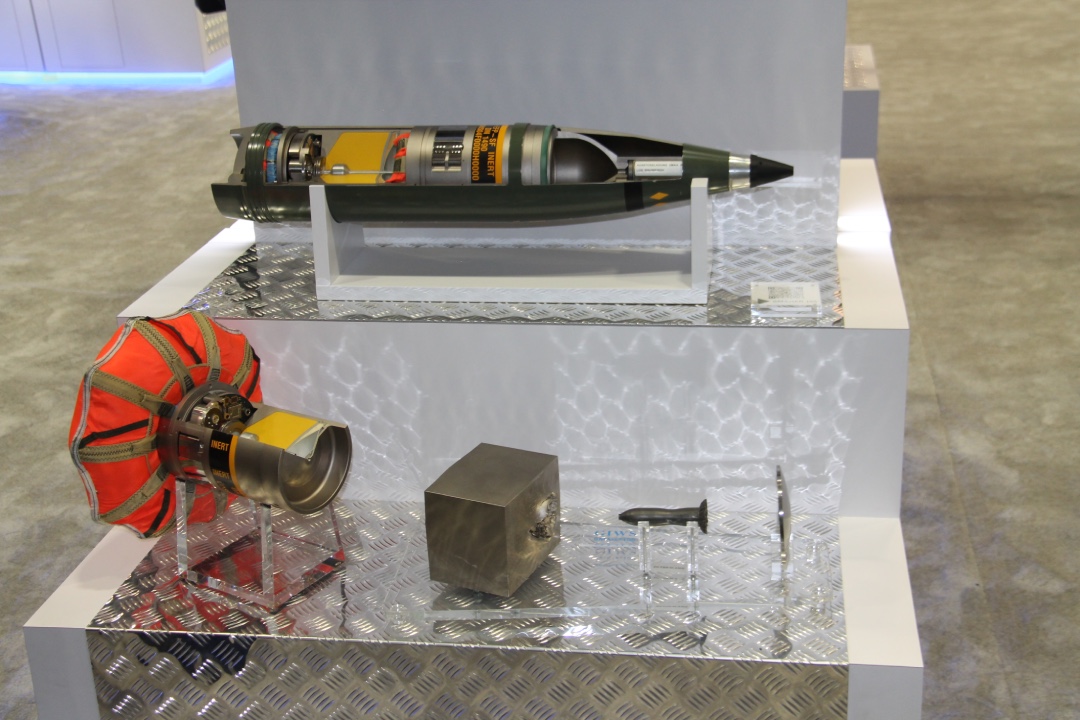
Artillery rockets
These have traditionally being area effect weapons as they are unguided but there is also a trend to give these a more precision effect.
The US Lockheed Martin M270 Multiple Launch Rocket System (MLRS) fired a 227mm M26 unguided rocket out to a maximum range of 31.6km (nearly 20 miles) with the warhead containing 644 M77 Dual-Purpose Improved Conventional Munitions (DPICM). This was followed by the extended range version which had more propellant but only 518 DPICM with range increased to 45.5km (over 28 miles).
Production of both of these has been completed and were followed in production by the Guided MLRS with a range of over 70km (43 miles) and which was originally developed to meet requirements of not only the US but also France, Germany and UK for use with their upgraded tracked M270 tracked launchers.
These rockets are also fired from the High Mobility Artillery Rocket System (HIMARS) based on a Family of Medium Tactical Vehicles (FMTV) 6×6 cross-country truck with a protected forward control cab. HIMARS has one pod of six rockets compared with the tracked M270 launcher which has two pods each of six 227mm rockets.
To engaged targets at longer range the US Army fielded the Army Tactical Missile System (ATACMS) with the tracked M270 MLRS capable of carrying two pods. The original one had a warhead containing 954 M74 DPICM and a maximum range of over 165km (102 miles). This was followed by versions with range increased to 300km (186 miles), improved accuracy and a blast fragmentation warhead.
In the longer term the ATACMS will be replaced by the Precision Strike Missile (PSM) with a range of nearly 500km (310 miles).
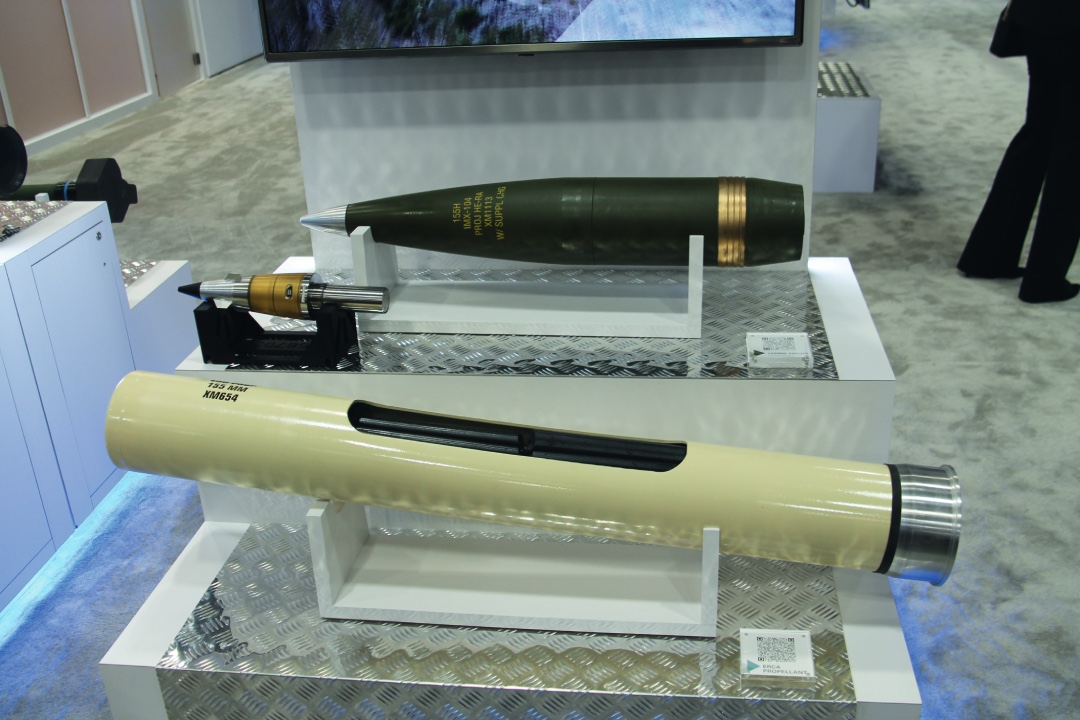
China, Israel, India, Turkey and Russia and other have already fielded a wide range of ARS with the Russian BM-21 122mm (40-round) system being the most widely deployed and reverse engineered by many countries, especially in the Middle East.
The BM-21 fired a 122mm unguided rocket out to a range of 20km (12.4 miles) but this was followed by rockets with ranges of up to 30km (18.6 miles) and 40km (24.8 miles) and more recently guided 122mm rockets have been developed to provide a precision effect.
Russia has also fielded the 220mm (16-round) Urgan which initially fired unguided rockets out to a range of 35km (21.7 miles), but again new rockets have been developed with an increase in range.
The largest Russian rocket launcher is the 300mm (12-round) Smerch which has been built in large numbers for the home and export markets with early versions firing unguided rockets having a maximum range of 70km (43.5 miles) with the latest ones having an extended range.
In addition to firing rockets fitted with warheads carrying sub-munitions, other warheads types have been developed for the 300mm rockets including fragmentation grenades, top attack sub-munitions, anti-tank mines, fuel-air explosive and even an unmanned aerial vehicle (UAV) which could be launched to acquire the target or to carry out post-strike damage assessment.
For NATO countries, the deep strike mission is normally carried out by the air force but this in changing with the introduction of longer range missiles.
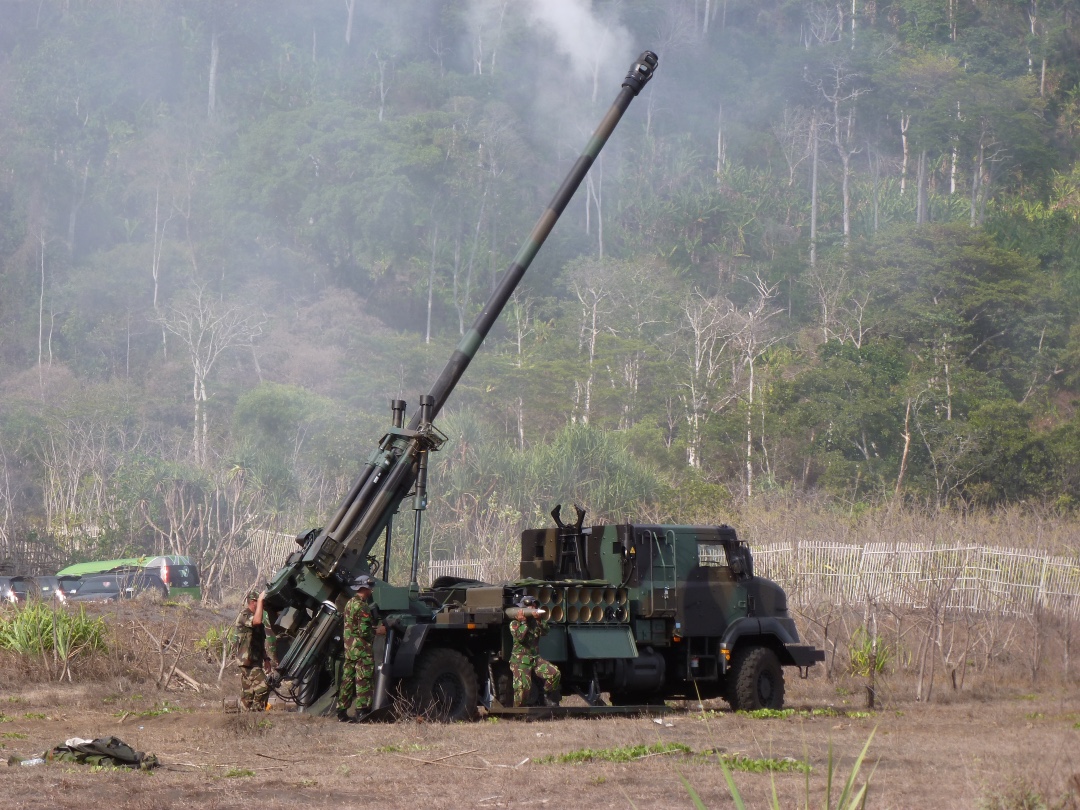
Finding the target
While the user is demanding more range and greater accuracy the Achilles heel will always be target acquisition. Targets can still be located using forward observers equipped with a suite of day/night observation devices, laser rangefinders, land navigation and communications systems.
But targets at longer ranges have to acquired by other means such as electronic warfare and signals locating systems, ALR, sound ranging systems, fixed and rotary wing assets and increasingly UAVs.
The latter also need to be equipped with a variety of sensors to enable targets not only to be rapidly located but this information passed down the chain of command to the artillery battery to rapidly carry out the fire missions.
Many users are now operating their artillery systems on ‘shoot and scoot’ missions in which they will only remain in one position for perhaps four minutes while the carry out a fire mission. This makes them very difficult to be engaged by counter-battery fire.
by Christopher F. Foss












